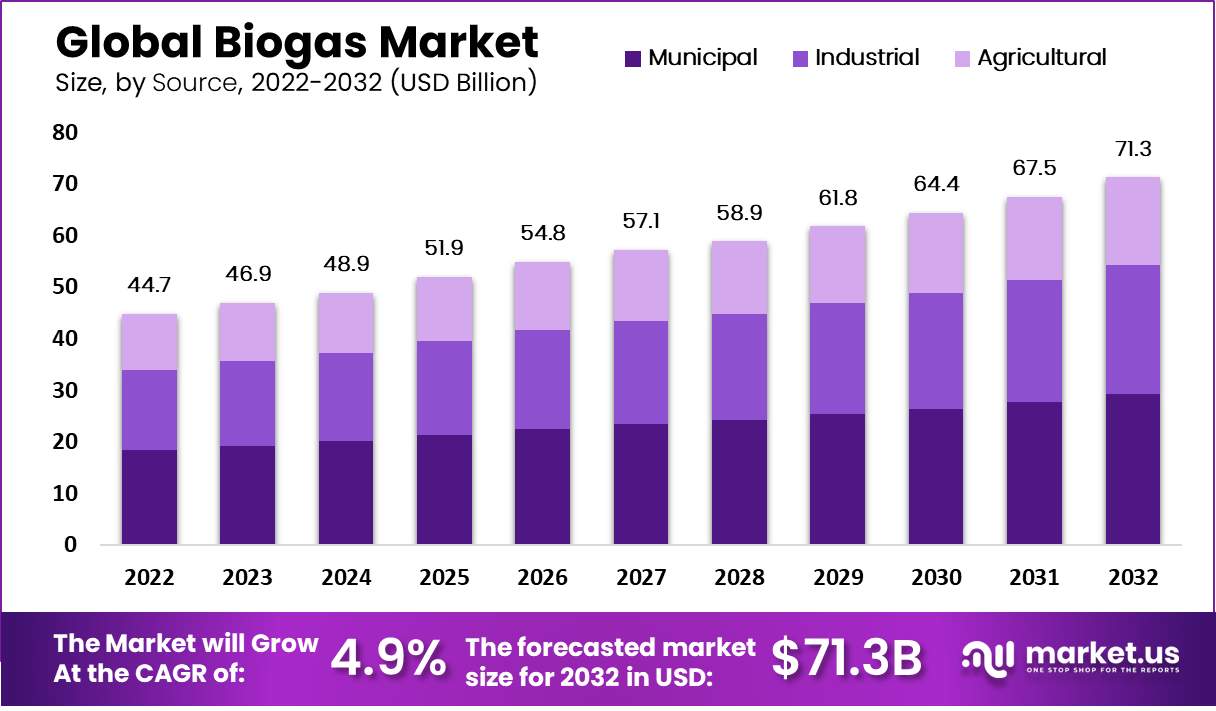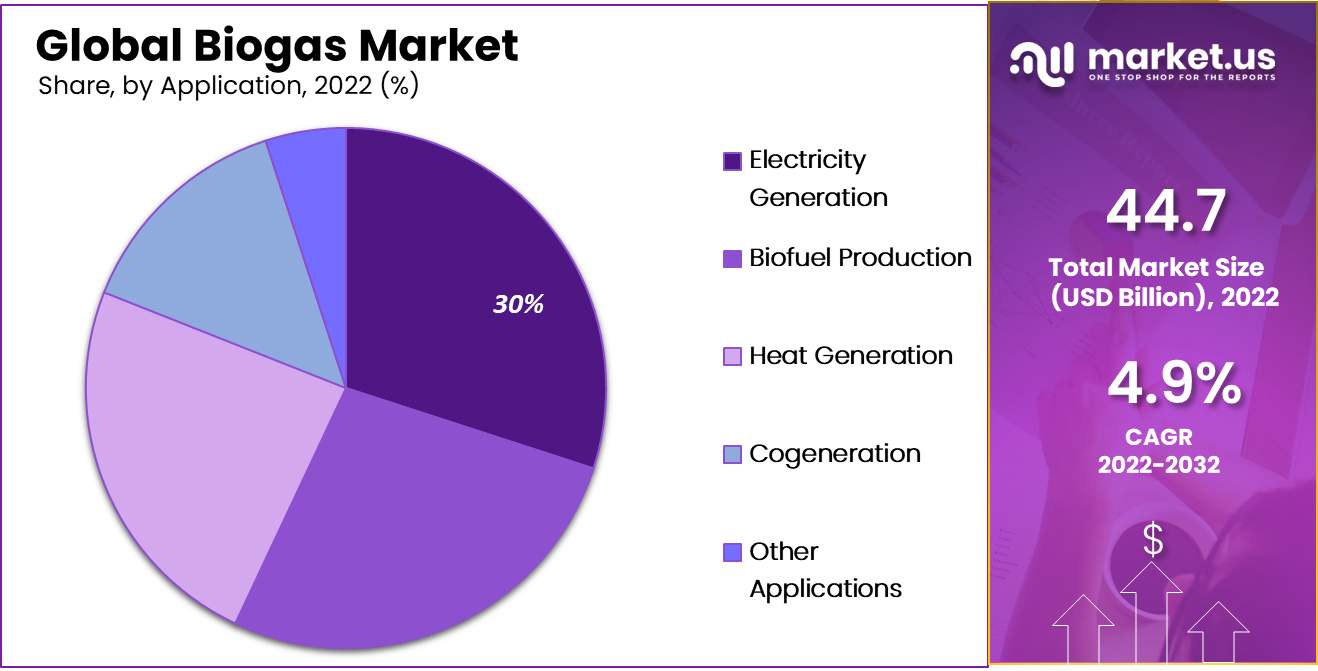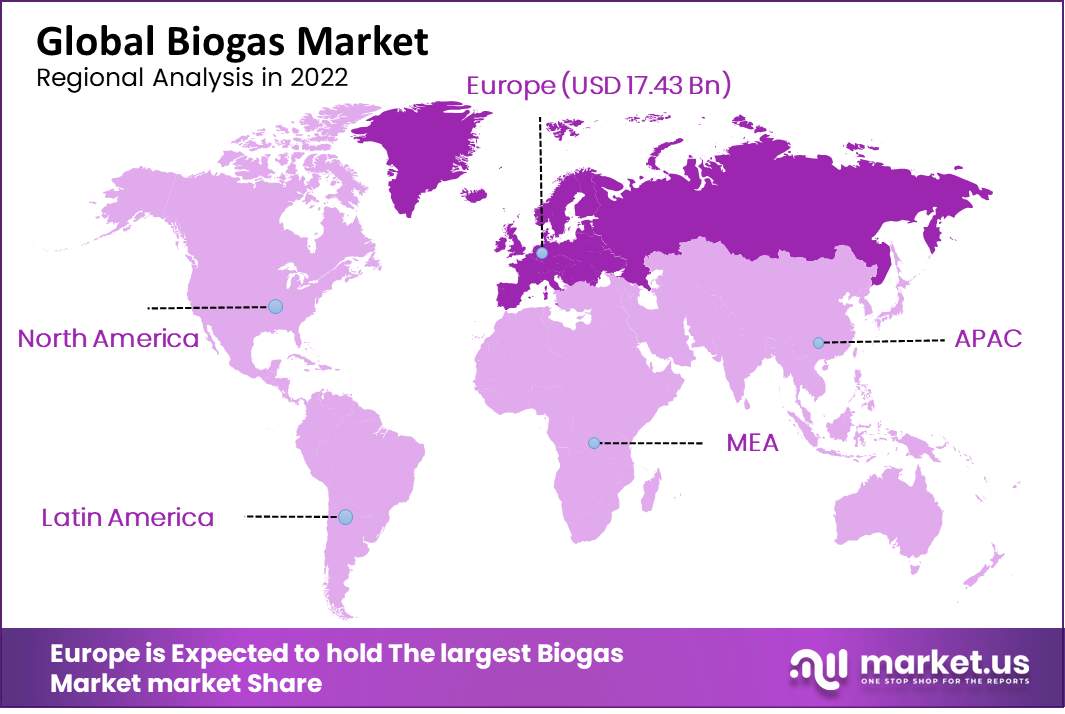Global Biogas Market By Source (Municipal, Industrial, and Agricultural), By Application (Electricity Generation, Biofuel Production, and Other Applications), By Region and Companies - Industry Segment Outlook, Market Assessment, Competition Scenario, Trends, and Forecast 2023-2032
- Published date: Oct 2023
- Report ID: 26684
- Number of Pages: 248
- Format:
- keyboard_arrow_up
Quick Navigation
Report Overview
In 2022, the biogas market size accounted for USD 44.7 billion. This market is estimated to reach USD 71.3 billion in 2032 growing at a CAGR of 4.9% between 2023 and 2032.
The global biogas market is an extremely dynamic sector within renewable energy. Produced through anaerobic digestion or fermentation of organic material, biogas provides a versatile energy source that typically contains 50-70% methane, 30-50% carbon dioxide, and small amounts of other gases.
Biogas production starts with collecting organic waste materials such as agricultural residues, food waste, sewage sludge, and energy crops for processing in anaerobic digesters; microorganisms then break down this organic matter without resulting in biogas.
Numerous factors have contributed to the rise of global biogas markets; among them being increasing environmental concerns, sustainable energy needs, government support with favorable policies and incentives as well as potential economic benefits of producing biogas.

Key Takeaways
- Market Size and Growth: The global biogas market was valued at USD 44.7 billion in 2022 and is projected to grow steadily to reach USD 71.3 billion by 2032 with an anticipated compound annual growth rate (CAGR) of 4.9% between 2023-2032.
- Biogas Composition: Biogas typically consists of 50-70% methane and 30-50% carbon dioxide as its core constituents, along with small quantities of other gases produced through anaerobic digestion or fermentation of organic materials.
- Driving Factors of Biogas Market Growth: The growing biogas market can be attributed to environmental concerns, favorable government policies, and incentives, as well as its economic advantages. Countries all around the globe offer financial incentives designed to lower capital costs associated with producing biogas production thereby encouraging biogas production.
- Source of Biogas: Biogas is sourced from municipal, industrial, and agricultural sectors. Municipal waste, including food scraps and yard debris, is a primary source. Industrial facilities like distilleries and food processing plants also contribute. Agricultural sources include manure, energy crops, and residues.
- Applications: Biogas is used for electricity generation, biofuel production, heat generation, cogeneration, and other applications. Electricity generation accounted for 30% of the market share in 2022. It can power homes, businesses, and the grid.
- Regional Dominance: Europe dominates the global biogas market with a 39% market share, driven by technological advances and increased investments in refinery industries. Italy, for example, is making efforts to decarbonize its market.
- Key Players: Major players in the biogas market include Air Liquide, PlanET Biogas, Wartsila, EnviTech Biogas AG, Robert Bosch GmbH, Schmack Biogas GmbH, and others. These companies have full-scale manufacturing capabilities and invest in innovative biogas generation methods.
- Recent Developments: Notable recent developments in the industry include agreements for power purchase agreements (PPA) for biogas-generated electricity and significant investments in compressed biogas (CBG) plants in various regions.
Driving Factors
Biogas is produced using organic waste such as agricultural residue, food waste, or sewage as a renewable energy source. Many governments around the world provide financial incentives for biogas producers.
These incentives help mitigate the high capital costs associated with biogas facilities, making their entry into the market. With increasing awareness of environmental problems such as climate change and their search for sustainable energy solutions.
Biogas provides an alternative fuel option, driving the market growth. Thanks to technological innovations, more biogas plants are being constructed around the globe; the quality and quantity production of biogas production has been enhanced through anaerobic digesters; this increase has coincided with increased urbanization and industrial activity producing more waste materials that need processing into biogas fuel for use as an energy source.
Restraining Factors
The Biogas plant market can be costly for small-scale projects, which is often an impediment to investment, especially in developing countries. Furthermore, their production relies heavily on organic feedstocks such as animal waste, food scraps, or energy crops – often scarce resources that make biogas production more challenging in certain regions and may make increasing biogas output harder than it needs to be.
Biogas production is an intricate process involving various technologies and equipment. Maintaining optimal conditions for biogas can be challenging, with equipment failure being an expensive reality.
Lack of infrastructure. Biogas production relies heavily on having access to digesters and pipelines – something many rural or remote areas lack access to.
By Source Analysis
Based on source, the biogas market can be divided into municipal, industrial, and agricultural segments; among these sources, municipal is most prevalent with 41% market share.
Household waste or municipal waste is one of the primary sources for biogas production – this can include food scraps, yard debris, and other organic materials collected and processed through anaerobic digesters into biogas production.
Distilleries, breweries, and food processing plants generate large volumes of organic biogas market waste that can also be utilized as sources for creating biogas.
Agriculture sources play a crucial role in biogas production. Manures or livestock waste that contains large amounts of organic matter will be utilized for biogas creation, while biogas can also be extracted through biomass conversion from crops like corn and sugarcane crops.
By Application Analysis
Application-wise, the market can be broken down into electricity generation, biofuel production, heat generation, cogeneration, and other applications. Of these applications, electricity generation accounted for 30.0% market share as of 2022.
Biogas can be used to produce electricity through either a gas engine or turbine, powering homes, and businesses or distributed into the grid for wider community consumption.

Furthermore, its biofuel components such as biomethane or compressed natural gas (CNG) may be extracted for processing into various biofuel products.
Biogas can be used to generate heat for industrial processes or space heating in homes & buildings. Cogeneration, or combined heat and power (CHP), involves simultaneously producing electricity and heat at once.
Biogas makes an ideal fuel for this system because it generates both. Furthermore, other applications of cogeneration include cooking & lighting in developing countries where access to conventional energy sources is limited.
Market Key Segments
Based on Source
- Municipal-
- Landfill
- Wastewater
- Industrial-
- Food Scrap
- Wastewater
- Agricultural-
- Dairy
- Poultry
- Swine Farm
- Agricultural Residue
Based on Application
- Electricity Generation
- Biofuel Production
- Heat Generation
- Cogeneration
- Other Applications
Growth Opportunity
As sustainability and greenhouse gas decrease are becoming more important, renewable energy sources are in demand. Biogas is an energy source that is pure and made from organic waste.
Many governments offer incentives and implement policies to encourage the usage of renewable energy sources including biogas. Tax incentives, feed-in tariffs, and renewable energy targets are all included. Biogas is being used more in different sectors.
Biogas adoption will increase as more industries realize the benefits. Biogas is becoming more affordable and easier to produce thanks to technological advances.
Biogas is expected to grow in the next few years due to the increasing demand for renewable energies, government policies, incentives, adoption by various sectors, and technological advancements.
Latest Trends
Biogas plants employ advanced technologies to increase productivity. These include artificial intelligence, data analytics, and machine learning – with demand growing across industries like agriculture, transportation, and energy generation in pursuit of carbon neutrality.
Biogas can help lower greenhouse gas emissions. The sector is currently moving toward novel business models that enable businesses to acquire biogas directly from producers, such as virtual power purchase agreements (VPP).
The Biogas business has experienced exponential growth over recent years. Biogas production now forms an important industry alongside wastewater treatment, agriculture, and food processing.
Circular economy principles and using waste material as feedstock have become an increasing focus in the biogas business, leading investors to show greater interest in this market. New plants are being constructed and existing ones expanded.
Biogas market growth is quickly expanding thanks to innovative business models, technologies, and applications. It is expected that demand for renewable and sustainable sources of energy will drive this industry even further forward.
Regional Analysis
By the regional analysis, Europe region dominates the market with a 39% market share.
The European biogas sector is growing due to technological advances and increased investments in refinery industries across Europe. The European biogas industry is growing due to technological developments and increasing investments in the region’s refinery industry.
The biogas market will grow across Europe biogas market. In Italy, efforts by the government are driving the market towards decarburization. Eni SpA, a Costner-family holding, agreed in March 2021 to purchase an Italian biogas firm from FRI EL Green Power through its circular economy division, Eco fuel. The acquisition is still awaiting approval from the antitrust authorities.

Key Regions and Countries
- North America
- The US
- Canada
- Mexico
- Western Europe
- Germany
- France
- The UK
- Spain
- Italy
- Portugal
- Ireland
- Austria
- Switzerland
- Benelux
- Nordic
- Rest of Western Europe
- Eastern Europe
- Russia
- Poland
- The Czech Republic
- Greece
- Rest of Eastern Europe
- APAC
- China
- Japan
- South Korea
- India
- Australia & New Zealand
- Indonesia
- Malaysia
- Philippines
- Singapore
- Thailand
- Vietnam
- Rest of APAC
- Latin America
- Brazil
- Colombia
- Chile
- Argentina
- Costa Rica
- Rest of Latin America
- Middle East & Africa
- Algeria
- Egypt
- Israel
- Kuwait
- Nigeria
- Saudi Arabia
- South Africa
- Turkey
- United Arab Emirates
- Rest of MEA
Key Players Analysis
Global biogas is a very competitive industry due to the large number of companies that are present in different regions. Air Liquide, PlanET Biogas, Wartsila, EnviTech Biogas AG. Robert Bosch GmbH. Asia Biogas.
Schmack Biogas GmbH. Air Liquide, PlanET Biogas, Wartsila, and EnviTech Biogas AG all have full-scale manufacturing capabilities. They are also leaders in R&D investment for introducing innovative ways to the generation of biogas.
Market Key Players
- Agrinz Technologies GmbH
- Air Liquide
- DMT International
- Gasum Oy
- Home Biogas Inc.
- PlanET Biogas
- Scandinavian Biogas Fuels International AB
- Schmack Biogas Service
- Total
- Xebec Adsorption Inc.
- Other Key Pl7ayers
Recent Developments
- In January 2022: Bio Construct announced in January 2022 that it had entered into a Power Purchase Agreement (PPA) for electricity with Next Craftwork, a German trading company based in Cologne. Next Craftwork will market 40,000MWh of biogas-generated electricity under the agreement. Bio Construct will be responsible for delivering electricity to its customers from the biogas plants. The fixed-price PPA involves 86 biogas CHPs.
- In May 2022: InterTech Fuel Solutions announced that it will invest INR 600 billion in its venture into compressed Biogas (CBG). The investment will be made in CBG across India next year. The project will be developed in phases. The first phase will see the establishment of four CBG plants each in Gujarat, Uttar Pradesh Punjab, and Haryana.
Report Scope
Report Features Description Market Value (2022) USD 44.7 Bn Forecast Revenue (2032) USD 71.3 Bn CAGR (2023-2032) 4.9% Base Year for Estimation 2022 Historic Period 2016-2022 Forecast Period 2023-2032 Report Coverage Revenue Forecast, Market Dynamics, COVID-19 Impact, Competitive Landscape, Recent Developments Segments Covered By Source-Municipal, Industrial, and Agricultural; By Application-Electricity Generation, Biofuel Production, Heat Generation, Cogeneration, and Other Applications Regional Analysis North America – The US, Canada, & Mexico; Western Europe – Germany, France, The UK, Spain, Italy, Portugal, Ireland, Austria, Switzerland, Benelux, Nordic, & Rest of Western Europe; Eastern Europe – Russia, Poland, The Czech Republic, Greece, & Rest of Eastern Europe; APAC – China, Japan, South Korea, India, Australia & New Zealand, Indonesia, Malaysia, Philippines, Singapore, Thailand, Vietnam, & Rest of APAC; Latin America – Brazil, Colombia, Chile, Argentina, Costa Rica, & Rest of Latin America; Middle East & Africa – Algeria, Egypt, Israel, Kuwait, Nigeria, Saudi Arabia, South Africa, Turkey, United Arab Emirates, & Rest of MEA Competitive Landscape Agrinz Technologies GmbH, Air Liquide, DMT International, Gasum Oy, Home Biogas Inc., PlanET Biogas, Scandinavian Biogas Fuels International AB, Schmack Biogas Service; Total, Xebec Adsorption Inc. Customization Scope Customization for segments, region/country-level will be provided. Moreover, additional customization can be done based on the requirements. Purchase Options We have three licenses to opt for: Single User License, Multi-User License (Up to 5 Users), Corporate Use License (Unlimited User and Printable PDF) Frequently Asked Questions (FAQ)
What is the value of the global Biogas Market?In 2022, the global Biogas Market was valued at USD 44.7 billion.
What will be the market size for Biogas Market in 2032?In 2032, the Biogas Market will reach USD 71.3 billion.
What CAGR is projected for the Biogas Market?The Biogas Market is expected to grow at 4.9% CAGR (2023-2032).
List the segments encompassed in this report on the Biogas Market?Market.US has segmented the Biogas Market Market by geographic (North America, Europe, APAC, South America, and MEA). By Source, market has been segmented into Municipal, Industrial and Agricultural. By Application, the market has been further divided into IElectricity Generation, Biofuel Production, Heat Generation, Cogeneration and Other Applications.
Which segment dominate the Biogas industry?With respect to the Biogas industry, vendors can expect to leverage greater prospective business opportunities through the Municipal sources segment, as this dominate this industry.
Name the major industry players in the Biogas Market.Agrinz Technologies GmbH, Air Liquide, DMT International, Gasum Oy, Home Biogas Inc, PlanET Biogas and Other Key Players are the main vendors in this market.

- Agrinz Technologies GmbH
- Air Liquide S.A Company Profile
- DMT International
- Gasum Oy
- Home Biogas Inc.
- PlanET Biogas
- Scandinavian Biogas Fuels International AB
- Schmack Biogas Service
- Total SE Company Profile
- Xebec Adsorption Inc.
- Other Key Pl7ayers
- settingsSettings
Our Clients
| Single User $4,599 $3,499 USD / per unit save 24% | Multi User $5,999 $4,299 USD / per unit save 28% | Corporate User $7,299 $4,999 USD / per unit save 32% | |
|---|---|---|---|
| e-Access | |||
| Report Library Access | |||
| Data Set (Excel) | |||
| Company Profile Library Access | |||
| Interactive Dashboard | |||
| Free Custumization | No | up to 10 hrs work | up to 30 hrs work |
| Accessibility | 1 User | 2-5 User | Unlimited |
| Analyst Support | up to 20 hrs | up to 40 hrs | up to 50 hrs |
| Benefit | Up to 20% off on next purchase | Up to 25% off on next purchase | Up to 30% off on next purchase |
| Buy Now ($ 3,499) | Buy Now ($ 4,299) | Buy Now ($ 4,999) |












